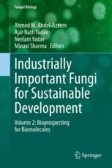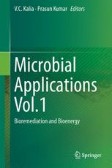Search
Search Results
-
Bioprospecting for Biomolecules from Different Fungal Communities: An Introduction
Fungi display an extraordinary level of structural and functional diversity with an estimated 1.5–5.1 million extant species. But, only 100,000...
-
Reprogramming Halomonas for industrial production of chemicals
Halomonas spp. are able to grow under a high salt concentration at alkali pH, they are able to resist contamination by other microbes. Development of Halomonas...

-
Carabids benefit more from pine stands with added understory or second story of broad-leaved trees favored by climate change than from one-storied pine stands
The released excess anthropogenic nitrogen and carbon produces habitat enrichment, as exemplified by the modification of one-storied pine stands by...

-
Biotechnological applications of archaeal enzymes from extreme environments
To date, many industrial processes are performed using chemical compounds, which are harmful to nature. An alternative to overcome this problem is...
-
Do astigmatid teeth matter: a tribological review of cheliceral chelae in co-occuring mites from UK beehives
The dentition of the chelal moveable digit in cohabiting astigmatids from UK beehives (i.e., Carpoglyphus lactis (Linnaeus), Glycyphagus domesticus ...

-
Distinct Osmoadaptation Strategies in the Strict Halophilic and Halotolerant Bacteria Isolated from Lunsu Salt Water Body of North West Himalayas
Two strict halophilic bacterial strains, Halobacillus trueperi SS1, and Halobacillus trueperi SS3, and three halotolerant bacterial strains, Shewanella...

-
Molecular Mechanisms of Fungal Adaptive Evolution
Fungi are ubiquitously distributed in almost all ecological niches in Earth’s biosphere, from underground soils to the stratosphere, from deserts to...
-
Macroentomology analysis: Methods, opportunities, and examples of reconstructions of paleoclimatic and paleoenvironmental conditions in the Quaternary of the northeastern Siberia
Macroentomology analysis mainly studies terrestrial insect species with a hard exoskeleton (Coleoptera, some Hymenoptera, Homoptera, and sometimes...
-
Diversity and Technological Aspects of Microorganisms from Semiarid Environments
Semiarid environments are characterized by the low water availability throughout the year. Hence, its microbial inhabitants are selected to be...
-
Xerotolerant bacteria: surviving through a dry spell
Water is vital for many biological processes and is essential for all living organisms. However, numerous macroorganisms and microorganisms have...

-
Changes in the population structure and abundance of mammals and birds in pasture ecosystems of the southern Minusinsk basin
The data from long-term observations (from 1970 to 2012) on changes in the population structure and abundance of mammals and birds under pasture load...
-
Species richness and zonal features of partial faunas of phytophagous beetles (Coleoptera, Chrysomeloidea, Curculionoidea) on grassy slopes in the east of the Russian Plain and the Cis-Ural Region
Comparative analysis of the fauna of phytophagous beetles (Chrysomeloidea, Curculionoidea) on grassy slopes in the east of the Russian Plain and in...
-
Marine Polyextremophiles and Their Biotechnological Applications
This chapter describes the versatility of marine microorganisms. They have inherent ability to grow and thrive under polyextremes. The bioactive...
-
Potassium-Solubilizing Microbes: Diversity, Distribution, and Role in Plant Growth Promotion
Injudicious application of chemical fertilizers in India has a considerable negative impact on economy and environmental sustainability. There is a...
-
Extremophilic Pectinases
Most of the harsh environments are filled with extremophiles. These extremophiles mostly adopted to such extreme conditions by secreting new...
-
Response Mechanisms to Chemical and Physical Stresses in Yeast and Filamentous Fungi
Free-living unicellular eukaryotes, including yeast and filamentous fungi, remain in close contact with the surrounding environment throughout their...
-
Physicochemical Boundaries of Life
Extremophilic organisms are found in all three domains of life - Bacteria, Archaea, and Eukarya. They tolerate or even require habitats which are...
-
Yeast Habitats: Different but Global
Yeasts, a taxonomically heterogenic group of unicellular fungi, populate many different habitats on our planet. They occur in aquatic and terrestrial...
-
Impact of technogenic pollution of urban environment on vitality indicators of urban biota (Mollusk fauna, soil mesofauna, epiphytic lichens)
Abstract—The article presents results of ecological, chemical, and bioindication assessment of the urban ecosystem of an industrial city in the South...
-
Secondary Metabolites of Mine Waste Acidophilic Fungi
Microorganisms isolated from an acid mine waste lake have proven an unexpected source of novel, bioactive metabolites. Berkeley Pit Lake is part of...
